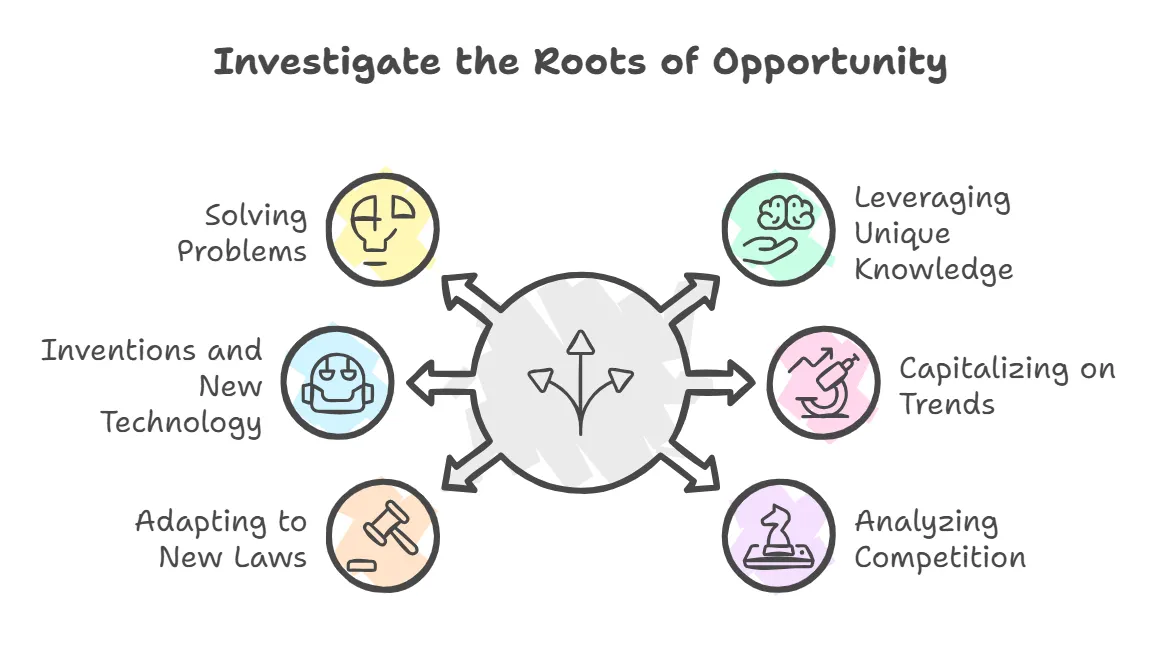6 Roots of Opportunity
Need a brilliant idea for a new business?

The 6 Roots of Opportunity: Finding Your Next Business Idea
Starting a business begins with spotting the right opportunity. The 6 roots of opportunity provide a structured way to identify ideas that could lead to successful ventures. Let's explore each root with examples:
Root 1: Problems Needing Solutions
What It Means: Many businesses start by solving a problem that people face in their daily lives. Examples:
- Snapchat: Solved the problem of temporary photo sharing, appealing to teens who wanted more privacy in their social media interactions.
- Trashbots: Created by teenage brothers Rohit and Sidharth Srinivasan, this company provides affordable robotics kits to schools, addressing the lack of accessible STEM education tools.
Guiding Questions:
- What frustrates you or your friends in daily life?
- Are there school-related issues that need solving?
- What takes too much time or effort in your routine?
Root 2: Unique Knowledge and Interests
What It Means: Your personal skills, experiences, or interests can uncover opportunities others might not see. Examples:
- FacePrint: Founded by 19-year-old Erin Smith, this company uses facial recognition technology to detect early signs of Parkinson's disease, based on her unique observation of patients' expressions.
- Jack's Stands & Marketplaces: Started by 13-year-old Jack Bonneau, this business helps other kids set up lemonade stands, leveraging his experience in running successful stands.
Guiding Questions:
- What skills or knowledge do you have that others might find valuable?
- Are there topics you're passionate about that you could turn into a business?
- What unique perspectives can you offer based on your experiences?
Root 3: Inventions/New Technology
What It Means: Advances in technology often create opportunities for new products or services. Examples:
- SmartCane: Developed by 16-year-old Riya Karumanchi, this device uses ultrasonic sensors to help visually impaired people navigate obstacles.
- ReThink: Created by teenager Trisha Prabhu, this app uses AI to detect and prevent cyberbullying.
Guiding Questions:
- How could existing technologies be applied in new ways to solve problems?
- What manual tasks could be automated or improved with technology?
- Are there any emerging technologies that excite you?
Root 4: Trends
What It Means: Social and cultural trends can reveal what people want now and in the future. Examples:
- TikTok: Capitalized on the trend of short-form video content, becoming hugely popular among teens.
- Depop: Tapped into the trend of sustainable fashion and online reselling, attracting many young users.
Guiding Questions:
- What's currently popular among your peers?
- Are there any new habits or interests gaining traction in your school or community?
- What social media trends could be turned into business ideas?
Root 5: New Laws
What It Means: Changes in laws and regulations can create opportunities for businesses. Examples:
- Juul: (Note: While controversial, it's a recognizable example) Capitalized on changing e-cigarette regulations, though later faced scrutiny over teen usage.
- Beyond Meat: Benefited from increasing regulations and consumer demand for sustainable food options.
Guiding Questions:
- Are there any new school policies that create opportunities?
- How are environmental regulations changing, and what businesses could help?
- What new laws are affecting how people live or work?
Root 6: Competition
What It Means: By analyzing competitors, you can find gaps in their offerings and create a better solution. Examples:
- Discord: Outperformed Skype by offering a more user-friendly platform for gamers and communities.
- Fortnite: Competed with other battle royale games by offering a unique building mechanic and frequent updates.
Guiding Questions:
- What popular products or services do you or your friends use that could be improved?
- Are there any underserved groups in your school or community?
- What businesses are missing in your local area?
Remember, the most successful businesses often combine multiple roots of opportunity. Stay observant, ask questions, and think creatively about how these roots might intersect to solve problems or meet emerging needs in your community or beyond.

